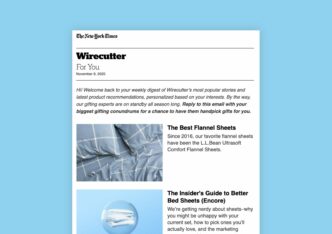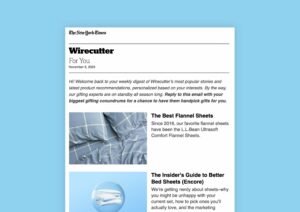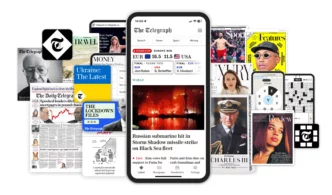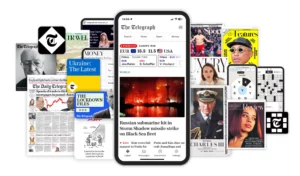

The classic, one-size-fits-all paywall model is out. Let’s start adapting our strategy to the reader’s profile or context, employing what we call a dynamic paywall. But whilst the assumption is that this requires a complicated, expensive, machine-learnt technology, this is far from the truth. In this article we explain why, sharing how some publishers are already making use of dynamic paywall models to better convert their readers into subscribers.
What does it mean for a paywall to be dynamic?
A dynamic paywall is one that adapts to the reader’s profile or context, i.e. there isn’t just one paywall that is presented to all visitors to the site. Instead, the publisher segments their audience to develop and test different paywall designs, messaging and subscription offers for different audiences.
The misconception with dynamic paywalls
Despite the (clear) benefits of dynamic models, the large majority of publishers are still employing a one-size-fits-all, spray-and-pray paywall.
But will mobile users act the same as those on desktop?
Data has already proven that this isn’t the case.
And what about a reader who is visiting your site for the first time? Do they have the same propensity to subscribe as someone who visits multiple times a week? What about a reader who has created an account?
Data has already proved that these readers don’t convert the same. In fact, registered readers are up to 40x more likely to subscribe.
And what about traffic from Facebook vs direct search?
(It’s very hard to find data for this, but the idea comes back to whether the reader is aware of your value yet. Someone who knows you well and comes directly from search or from a newsletter will be more engaged in your content compared to someone who is just browsing through social media or Google News and happens to come across one of your articles.)
Ok, so I’ve proven my point.
How can you put a strategy in place that recognizes these different behaviors and adapts the paywall accordingly?
Perhaps the misconception with dynamic models is that you need an expensive, complicated machine learning algorithm that takes time (and money) to implement. And whilst these AI models that learn and adapt over time without human intervention are incredibly valuable for publishers, they aren’t the only way to be dynamic.
In fact, implementing a dynamic model can start with some very (very) simple strategies that will still make a significant difference to your overall conversion rates.
Implementing a simple but effective dynamic paywall strategy
Before you start….
The very basis of dynamic strategies is that they adapt to your audience. But how can you build a successful dynamic model if you don’t know who your audience is?
As analyst and founder of A Media Operator Jacob Donnelly recently discussed at FIPP’s Media Congress, “You have to start every conversation with the who, and really be clear about who the audience is, so that you can get everything else right.”
Analyze where your audience comes from, what they read, how they read, how often, who has the highest conversion rate…
To achieve this, we’d recommend starting with an anonymous to known (registration) strategy before launching straight into subscription.
Ask your users to create a free account in exchange for access to more content and other benefits, allowing you to collect first-party data, assign this data to a single reader ID and work to increase engagement over time for this known user.
> Not only this, but registration also supports revenue diversification as it increases both advertising revenue and propensity to subscribe. Find out more in our dedicated article here.
Choose how to segment your audience based on data.
- Source of traffic, e.g. Facebook/Twitter vs Direct vs Newsletters
- Level of engagement, e.g. Volatiles, Occassionals, Regulars & Fans – this could be based on the RFV (recency, frequency, volume) score used by Financial Times with divisions between each segment being defined based on your audience behavior
- Anonymous vs registered
- Location, e.g. France vs United States
- Device used, i.e. mobile vs desktop
- Never subscribed vs ex-subscriber
- Content type, e.g. politics vs news vs lifestyle
Test wall variations to discover which works best for each audience segment
What can you test?
- The design: colors, images, photos (e.g. test adding a photo of a journalist), format (banner, box or pop-up)
- The offers: annual vs monthly pricing, discounted offer, number of offers on the wall…
- The wording: value proposition, personalization to the person or the content-type…
- Form fields in the wall: email collect, name, etc
Importantly, you should define what success looks like for a wall. Traditionally, these are click-through or user-to-subscriber conversion rates, however we’d also recommend thinking about the steps in the reader funnel toward subscription, because a user is highly unlikely to arrive on your website for the first time and subscribe. This funnel will therefore look different for each user segment.
For instance, for anonymous users, success might be converting them into a registered member.
For traffic coming from social media sites, it could be to sign them up to your newsletter to increase engagement and form a content consumption habit.
Some simple ideas to get started
Personalizing your paywall can start from the very simple, such as adapting the currency of your subscription offer to the reader's location, to the more complex, for instance building different conversion journeys based on a user's level of engagement.
Jeune Afrique
Audience segmented by: location
Dynamic element: value proposition messaging
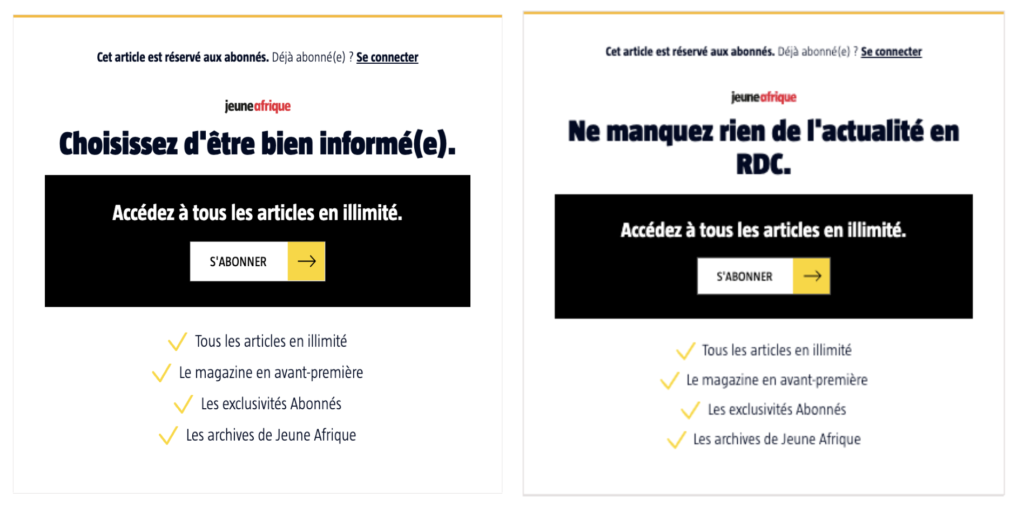
On the left: Choose to be well-informed
On the right: Don’t miss out on any news from the Republic of Congo (RDC)
This messaging repositions the publisher as not only one that covers news across the continent, but also on a more local, national level, providing news on the subjects that matter to the reader’s own community. This simple change to their value proposition means they can convey similar values as smaller, local publishers who often have a tighter-knit, more engaged community of readers who buy into the media’s mission.
Le Télégramme
Audience segmented by: reader conversion journey
Dynamic element: Type of conversion steps prior to subscription
Arguably one of the most valuable dynamic strategies is segmenting audiences based on level of engagement, a key signal as to whether a reader is likely to subscribe or not.
Le Télégramme uses Poool’s dynamic paywall solution and their native audience segmentation that divides readers into 4 engagement groups – Volatiles, Occassionals, Regulars and Fans.
Volatile visitors, who only visit about once a month, will likely be frustrated by your paywall, turning away from your site as they haven’t yet had the chance to engage in your content and discover the value that you offer. Instead, you could consider a softer conversion wall, such as newsletter subscription or free registration to increase engagement.
As for Fan readers, who visit multiple times a week and are already highly engaged, a little frustration (created by the paywall) is actually beneficial to help encourage conversion.
On Le Télégramme, content is split into free and premium. Free content is always open, whilst the strategy employed for premium content differs based on the user’s level of engagement.
For Fan users, a paywall blocks premium content after a few lines.
Whilst less engaged user segments are encouraged to create a free account:
This allows less engaged users to discover more of the publisher’s premium content to increase propensity to subscribe. As for Le Télégramme, registration allows them to collect key data points on the reader to learn more about their interests and further personalize their experience to make them more likely to convert in the future.
Financial Times
Audience segmented by: Location
Dynamic element: Value proposition messaging
FT modifies the value proposition messaging based on a user’s location, with the first being presented to UK readers, whilst the second is for those reading from the US. Especially with niche content such as this (FT covers financial and political news), user interests will differ greatly across the world and even within a given country.
Given that FT is a UK publisher, American readers need a different reason to subscribe (aside from simply to hear about political and financial news). Messaging needs to tell these audiences why they should choose FT over an American equivalent.
Financial Times has chosen here to focus on the ‘global perspective’ that they can provide, on ‘the US and beyond’, comparing the FT subscription to global citizen
ELLE Magazine
Audience segmented by: Type of newsletter subscription
Dynamic element: The value proposition, benefits of subscription and image
On the left, a wall presented to readers coming from the sex and relationships newsletter, with a value proposition and the first two benefits of subscription being adapted to this topic.
On the right, the same thing but messaging and the image is adapted to those signed up to ELLE’s fashion newsletter.
This is a brilliant, very simple but effective strategy. Thanks to the newsletter, you know that this reader has an interest in this specific topic, so why not maximize this insight to better convert them into a subscriber? Whilst the premium offer being promoted is the same in both cases, the benefits being forefronted are adapted to the reader’s interest, helping them to see the value of converting.
The Washington Post
Audience segmented by: Location
Dynamic element: Currency
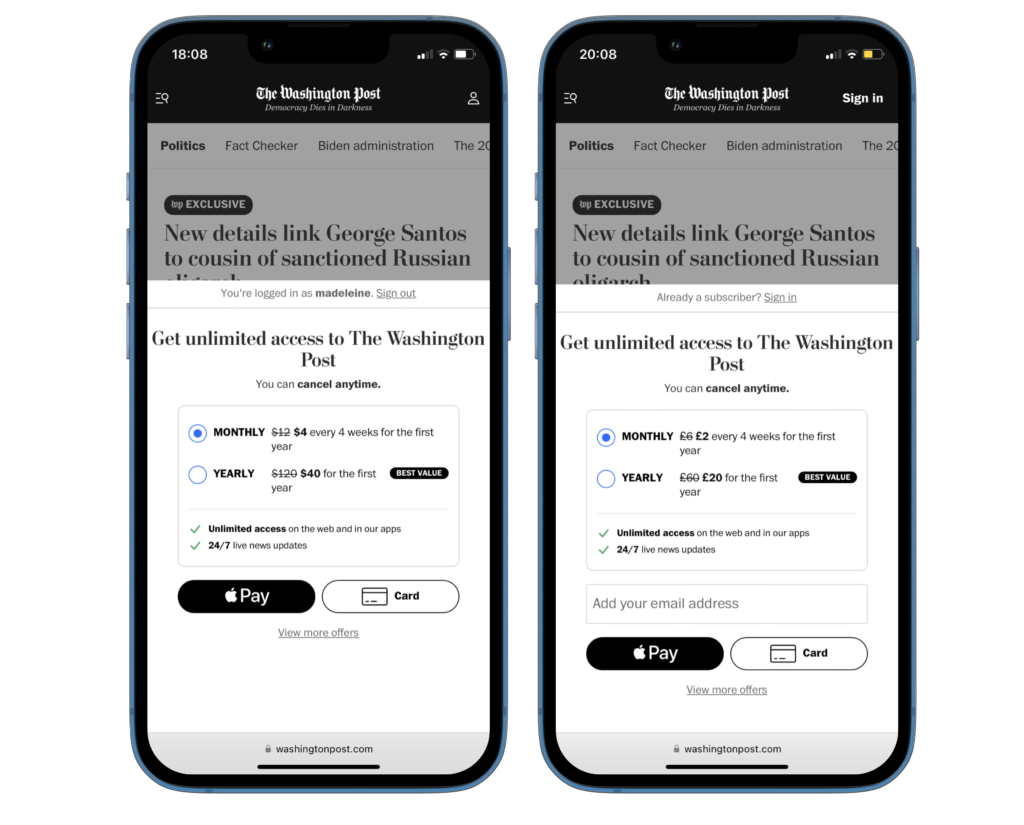
When I say that dynamic paywall strategies can be simple but effective, this is a prime example. Here we have the paywall shown to readers in the US vs UK, with just the currency that differs. Despite seeming like an obvious aspect of the paywall and subscription offers to change, this level of personalization and detail is essential for success and can be a great starting point to develop your dynamicity from here.
Le Journal du Dimanche
Audience segment: users who had already started the subscription process but had abandoned before payment
Dynamic element: Value proposition messaging
“Complete your subscription is just a single click and gain access to all our articles”
Focus is on the simplicity and speed of the conversion process (“a single click”) and the benefits of doing this action (“access to all articles”) helping to give a final nudge to this audience segment who are so close to subscribing.
Test, learn and test again
Ultimately, however, only testing will allow you to find the optimal dynamic strategy for your unique audience.
Discover some of our other content to help you out here:
- A/B testing paywall benchmarks
- How publishers are using A/B testing to increase conversion rates
- Constantly evolving product offerings with A/B testing at Netflix



